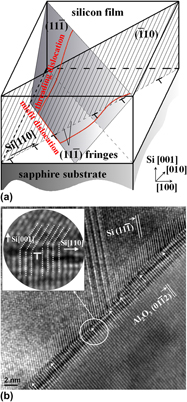Crossref Citations
This article has been cited by the following publications. This list is generated based on data provided by
Crossref.
Moridi, Alireza
Ruan, Haihui
Zhang, L.C.
and
Liu, Mei
2013.
Residual stresses in thin film systems: Effects of lattice mismatch, thermal mismatch and interface dislocations.
International Journal of Solids and Structures,
Vol. 50,
Issue. 22-23,
p.
3562.
Liu, Mei
Ruan, Haihui
and
Zhang, Liangchi
2013.
Variation of crystal quality and residual stresses in epitaxially grown thin film systems induced by ion implantation and annealing.
Journal of Materials Research,
Vol. 28,
Issue. 11,
p.
1413.
Moridi, Alireza
Ruan, Haihui
Zhang, Liangchi
and
Liu, Mei
2014.
On the dependence of surface undulation on film thickness.
Journal of Physics and Chemistry of Solids,
Vol. 75,
Issue. 4,
p.
500.
Liu, M.
Ruan, H.H.
Zhang, L.C.
and
Moridi, A.
2015.
Temperature-dependent residual stresses in a hetero-epitaxial thin film system.
Thin Solid Films,
Vol. 584,
Issue. ,
p.
186.
Javed, Hassan
Merle, Benoit
Preiß, Eva
Hivet, Romain
Benedetto, Alessandro
and
Göken, Mathias
2016.
Mechanical characterization of metallic thin films by bulge and scratch testing.
Surface and Coatings Technology,
Vol. 289,
Issue. ,
p.
69.
Dariani, R.S.
and
Nazari, M.
2016.
Comparison of stress, strain, and elastic properties for porous silicon layers supported by substrate and corresponding membranes.
Journal of Molecular Structure,
Vol. 1119,
Issue. ,
p.
308.
Austin, D. Z.
Holden, K. E. K.
Hinz, J.
and
Conley, J. F.
2017.
Electrode modulated capacitance-electric field nonlinearity in metal-insulator-metal capacitors.
Applied Physics Letters,
Vol. 110,
Issue. 26,
Karoui, A.
Sahtout, F. K.
and
Vlahovic, B.
2017.
Time-dependent nonlinear finite element modeling of the elastic and plastic deformation in SiGe heterostructured nanomaterials.
Journal of Applied Physics,
Vol. 121,
Issue. 2,
Tillmann, Wolfgang
Fehr, Alexander
Stangier, Dominic
and
Dildrop, Markus
2019.
Influences of substrate pretreatments and Ti/Cr interlayers on the adhesion and hardness of CrAlSiN and TiAlSiN films deposited on Al2O3 and ZrO2-8Y2O3 thermal barrier coatings.
Results in Physics,
Vol. 12,
Issue. ,
p.
2206.
Jo, Euije
Kim, Dongwan
and
Leem, Jae-Young
2020.
Facile Synthesis of ZnO Thin Films at Low Temperatures Using an Additive-Free Electrochemical Oxidation Method.
Korean Journal of Metals and Materials,
Vol. 58,
Issue. 9,
p.
645.
FANG, ZHIHAO
CHEN, LONGFEI
GUAN, YINGCHUN
and
ZHENG, HONGYU
2020.
PICOSECOND LASER MICROMACHINING OF SILICON WAFER: CHARACTERIZATIONS AND ELECTRICAL PROPERTIES.
Surface Review and Letters,
Vol. 27,
Issue. 05,
p.
1950142.
Tillmann, Wolfgang
Fehr, Alexander
and
Stangier, Dominic
2020.
Effects of heat treatments on the microstructure and the adhesion of Cr, Ti, Al, Zr HiPIMS films deposited on APS Al2O3 and ZrO2-8Y2O3 coatings.
Surface and Coatings Technology,
Vol. 393,
Issue. ,
p.
125766.
Tabatabaeian, Ali
Ghasemi, Ahmad Reza
Shokrieh, Mahmood M.
Marzbanrad, Bahareh
Baraheni, Mohammad
and
Fotouhi, Mohammad
2022.
Residual Stress in Engineering Materials: A Review.
Advanced Engineering Materials,
Vol. 24,
Issue. 3,
Xue, Nian-Pu
Wu, Qiong
Gao, Han-Jun
Ran, Zi-Liang
Li, Xin
Guo, Jian
and
Zhang, Yi-Du
2024.
A new thermal vibration mechanical shot peening coupling strengthening method.
International Journal of Mechanical Sciences,
Vol. 274,
Issue. ,
p.
109281.


